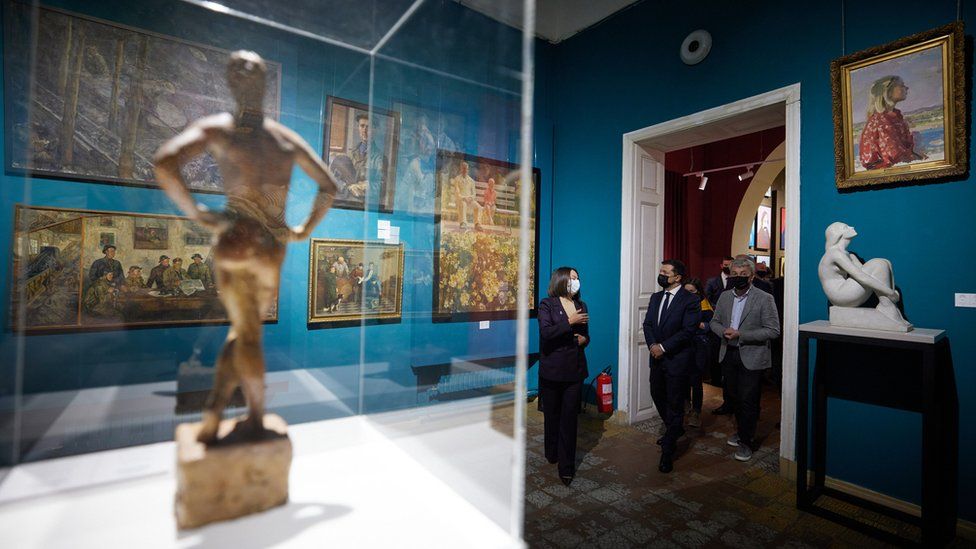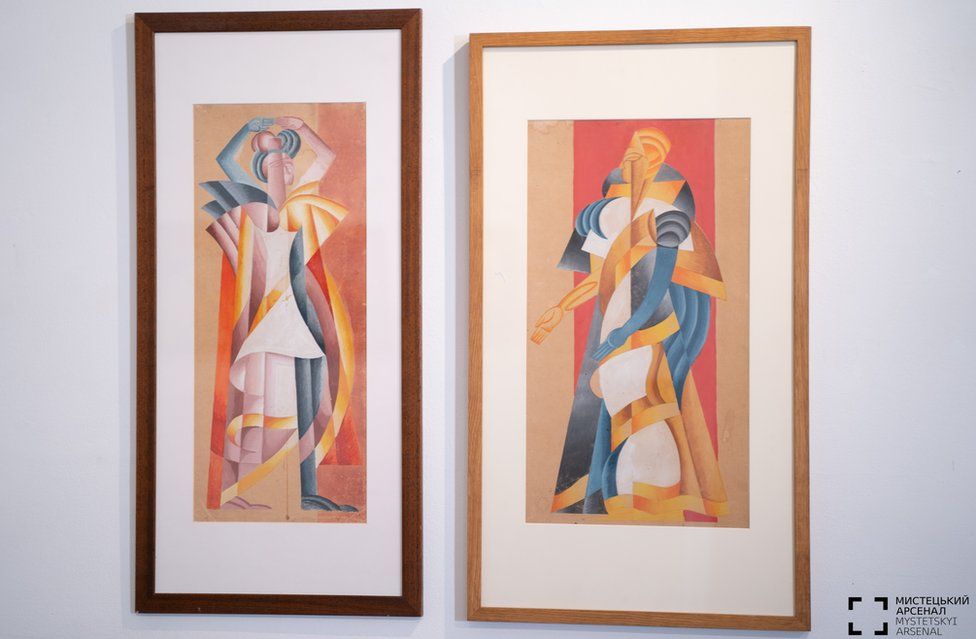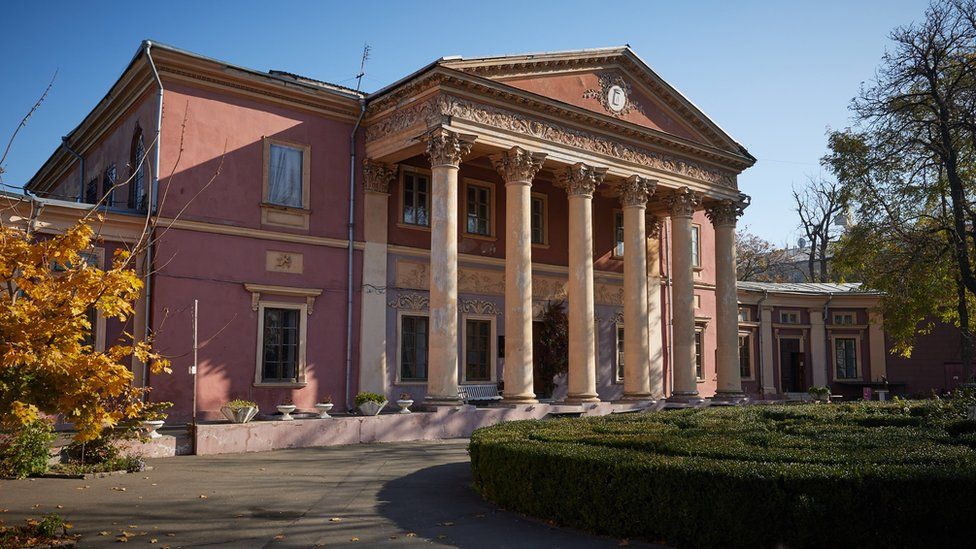The video showed a queue snaking around the outside of the Odesa Fine Art Museum. It was Sunday 20 February, and - perhaps for the last time - men, women and children were lining up to look at its treasures (10,000 artworks from the 16th Century onwards, including early paintings by Odesa's own, the abstract art pioneer, Wassily Kandinsky).
Now, like many cities across the country, Odesa, founded by Catherine the Great in the late 1700s, with its perfectly preserved 19th Century architecture and beautiful neo-baroque Opera House, prepares for attack. The museum's acting director, Oleksandra Kovalchuk, fled to Bulgaria for the sake of her one-year-old son. But she's terribly torn.
"I feel like a traitor," she told me. "I have let down my staff. Of course I feel guilty about it. Odesa Fine Arts Museum has been like a child to me for many years, so it was basically a decision about which child you want to abandon and I decided I'm obliged to take care of my little son."
In the Ukrainian capital, Kyiv, another museum director, Olesia Ostrovska-Liuta, has made a different but equally difficult decision. She's staying put, although she told me "the situation for museums and cultural institutions is no different from hospitals, schools and residential areas, we are all under shelling".
The Mystetskyi Arsenal is one of Europe's largest art museums, holding Ukrainian avant-garde and contemporary works. Protecting them is her mission and she says she will remain in Kyiv "as long as we can guard our institution".
"When it's not possible any longer, then the situation changes," she says.
"We are facing not just an attack on Ukraine but an attack on our culture," she told me over a Zoom line that stuttered and froze. She's in a war zone. Perhaps it's more surprising that it worked at all.
Ukraine is home to seven Unesco world heritage sites, including the St Sophia Cathedral in Kyiv with its wonderful golden domes and stunning Byzantine fresco of the Virgin Mary as well as the historic architectural showpiece at the centre of Lviv in the west.
As Anna Reid, author of Borderland: A Journey Through the History of Ukraine, puts it, bombing Lviv, Odesa, Kyiv or Chernihiv to the north, with its medieval churches, monasteries and peerless collection of icons will be "a cultural loss to Europe on the scale of the destruction of Dresden in World War Two".
When it comes to the country's museums, there may be little that staff can do to protect their buildings from Russian assault. And according to Kovalchuk, a lack of investment means museums "don't have a system that would manage fire".
"Whatever museum starts to get flame in it," she says, in almost perfect English, "it will burn down and we will lose many beautiful works of art and heritage and historical artefacts."
But there is a race under way to safeguard the treasures inside them and a dread understanding of the high price already being paid. Reports from Ivankiv, north-west of Kyiv, say that the local museum and its art works have been burned down by Russian forces.
Inside were 25 paintings by the celebrated Ukrainian folk artist Maria Prymachenko whose bold bright colours and naïve style led Pablo Picasso to deem her an "artistic miracle".
A few of the works were reportedly saved. According to The Times, a local man ran into the burning building to rescue as many as he could. It's thought he saved around 10 large artworks from the flames, although it's not yet clear which ones.
A few weeks before the war, according to the Kyiv-born art critic Konstantin Akinsha, the Ministry of Culture and Information Policy of Ukraine issued guidelines for protection and possible evacuation of museum collections.
Mr Akinsha says he was desperate for works to be evacuated immediately. He told me: "Our president is a hero, but that was at a time when he was saying there was nothing to panic about, that there would be no invasion. The authorities prevented the evacuation of artworks because they were afraid it would create panic."
I've been told of some of the efforts now being made across Ukraine's several thousand museums; of hasty attempts to create a full digital inventory of works, in case they fall into Russian hands, of attempts to move pieces to undisclosed locations and even of museum staff in some cases sleeping barricaded into cellars with the most precious artworks beside them.
Nobody wants to speak publicly about what is happening, for fear of alerting either the Russian invaders or looters. But Kovalchuk told me: "In almost every museum, workers are sleeping, staying for days to be close to the art, to be able to make some last minute decisions. I cannot tell you more unfortunately."
And when it comes to Odesa Fine Art Museum, she says she "did everything possible, whatever we can, to keep the collection safe".
All Ostrovska-Liuta would tell me about the Mystetskyi Arsenal museum is: "When the war started, we had our instructions for how to act in this situation. We did our security plans and we are acting according to them. The museum is shut and guarded."
With the Russians approaching Kyiv and explosions in the capital in recent hours, it may now be too late to move some of the city's more portable treasures out (many hope that may have already happened secretly in some cases at least).
But there is pressure to safeguard art works held in places that aren't yet under fire. Anna Reid says the cities which aren't occupied already, like Odesa and Lviv, which have museums with rich collections "should be given as much help as we can to get those collections to a place of safety", whether into air raid shelters or even out of the country.
For the buildings, which clearly can't be moved, it's a different story. "Lviv is like Salzberg," she says. "Odesa is a perfectly preserved 19th Century city, famous for its beautiful trees, its cobbled streets, its seafront. It's a jewel and it needs air defences."
Kyiv is already facing attack. Ostrovska-Liuta says: "We are all under great danger from the sky. That's why there's a strong appeal from all Ukrainians to establish a no flight zone over Ukraine."
Clearly, the people of Ukraine are the priority; safeguarding them as much as possible is most critical. But this is a nation with a proud history and a recent past that saw cultural figures and works of art destroyed by previous Soviet administrations. The fear is that the Russians want to repeat that."
Kovalchuk says: "I believe it would make sense for them to destroy art that shows our Ukrainian heritage, that shows we have different history, that we're different, not Russian. For this art, in the Russian Federation, there will be no place. It will cease to exist."




